Sunday, 12 October: The German Governor's Residence (Mao slept here)
Back in 1891, the Chinese powers that were had just designated a village named Jimo a city, for use as a military and industrial port, and had renamed it Tsingtao, when a couple of German missionaries in the region were murdered, and the German government used that as an excuse to invade and occupy the place (though precluding the establishment of a Chinese military port probably also had something to do with it). The settlement of the incident included an agreement whereby Germany got a permanent concession of territory in the city and installed a governor there. As it turned out, the concession lasted only until the end of WWI, when all Germany's possessions and concessions were confiscated. At this point Tsingtao was given, over China's and the city's protests, to Japan. But during that short period of the concession, Germany built their usual stuff, including a railway station (which we didn't get to see) and a Governor's residence, now a museum of the days of the concession and history of the building since.
Sunday morning looked like our only chance to see it, so we decided to take a taxi straight there. Conveniently (since we're still waking up at the crack of dawn), it opened at 8:30 a.m. I thought we could just show the taxi driver the paragraph photocopied from our guidebook, which gave the name of the place in Chinese characters, but to make sure, David thought we should have the reception desk write us a "please take us to" note. I accordingly showed my photocopied paragraph to the clerk and got as far as "We want to take a taxi here. Could you write . . ." before she whipped out a little pad of forms the size of business cards with the hotel's letterhead and a miniature map on one side and "Please take me to ______________" already printed on the other! She filled in the museum's name, we presented the card to one of the doormen, who waved to a cab from the rank out front, and we were whisked away to the place, which turned out to be at the top of a long hill that I'm glad we didn't have to climb on foot.
At the ticket office just inside the gate to the grounds, we asked for two tickets and were asked to show our passports! We did and were ushered in free; apparently the locals have to pay admission but foreigners (or at least Americans) don't. All our photos are from outside the house, because it's one of those annoying museums that forbids indoor photography.
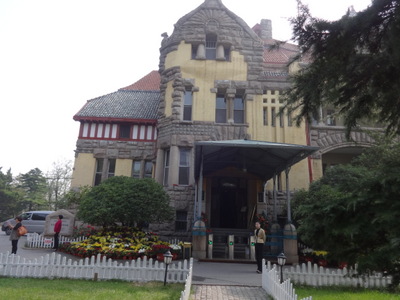
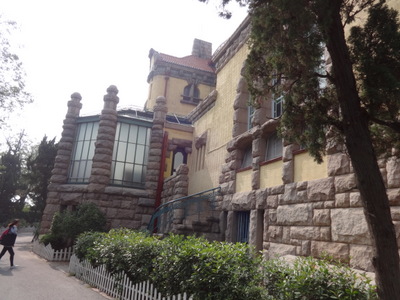 The house was, of course, quite Germanic but seemed substantial and comfortable. We got an English-language audioguide (called a "voice guide" here; I had to use pantomime to ask for it, as the word "audioguide" was unknown) for 20 yuan each, plus a 200 yuan deposit.
The house was, of course, quite Germanic but seemed substantial and comfortable. We got an English-language audioguide (called a "voice guide" here; I had to use pantomime to ask for it, as the word "audioguide" was unknown) for 20 yuan each, plus a 200 yuan deposit.
The residence was built in the first few years of the 20th century and was occupied by the last two of the four German governors. We saw the governor's office/study, his retiring room, the small (family) dining room, the larger (official) dining room, the conservatory (with state of the art technology for the time and ventilation openings opened and closed by chains on pulleys), the two-story main hall (where visitors could be seated to wait while the governor checked them out through a secret peephole from the second floor), the music/ball room, the childrens' bedroom and study/play room, and other areas (no bathrooms or kitchens, alas). Two pianos, an upright and a grand, are designated historical monuments in their own right, both 100-year old Steinways, still in good voice. The grand escaped damage during the cultural revolution because Mao's third wife played and looked out for it.
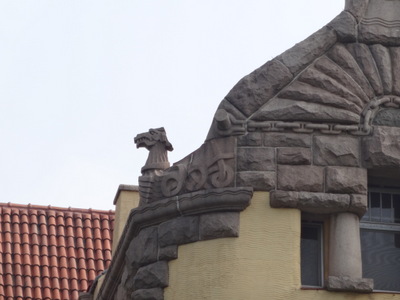
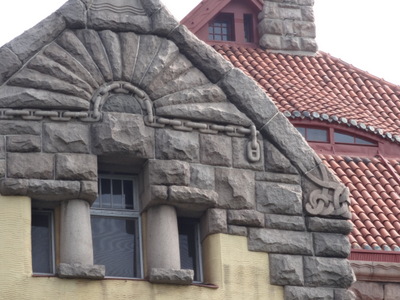 After the building finally reverted to China, its name was changed to "The Guest House," and it hosted official visitors to the city. Mao stayed there many times as did every other Chinese leader famous enough for me to have heard of. It became a museum in the sixties. The audioguide explained that the wood used in the construction was specially treated for durability, so the parquet floors and other woodwork are still uncracked and in perfect shape. Much of the furniture is old-fashioned heavy German construction, beautifully designed. The art nouveau decoration was mentioned frequently but showed up mainly as trim rather than major elements. David especially liked the ceilings. The chandeliers, on the other hand, were uniformly pretty ugly; maybe they were nicer when still copper colored rather than their present black.
After the building finally reverted to China, its name was changed to "The Guest House," and it hosted official visitors to the city. Mao stayed there many times as did every other Chinese leader famous enough for me to have heard of. It became a museum in the sixties. The audioguide explained that the wood used in the construction was specially treated for durability, so the parquet floors and other woodwork are still uncracked and in perfect shape. Much of the furniture is old-fashioned heavy German construction, beautifully designed. The art nouveau decoration was mentioned frequently but showed up mainly as trim rather than major elements. David especially liked the ceilings. The chandeliers, on the other hand, were uniformly pretty ugly; maybe they were nicer when still copper colored rather than their present black.
I wish we'd been able to photograph the green decorative tilework around the fireplaces, as most of it portrayed thistles (life-size plants assembled out of tiles, some of which portrayed flowers, some leaves, some stems, etc.). The audioguide went on at length about them, insisting that they were cornflowers, the emblem and favorite flower of Keiser Wilhelm I, but I'm here to tell you they were thistles. I've never seen thorns like that on cornflowers! Perhaps no one involved in the construction knew the difference.
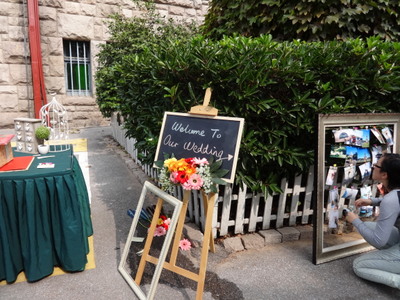
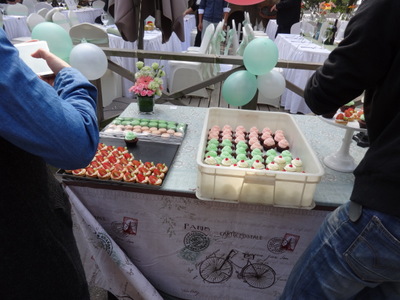 Outside on the grounds, no fewer than four different weddings were in preparation, one of which seemed to be bilingual. From the snapshots posted at the welcome table, we gathered that both partners were of Asian descent but that at least one of them was from an English-speaking country and had invited friends and family from there. The few non-Asian faces we saw hanging around there were among the extremely few we saw in China, apart from participants in the Biodiversity Conference.
Outside on the grounds, no fewer than four different weddings were in preparation, one of which seemed to be bilingual. From the snapshots posted at the welcome table, we gathered that both partners were of Asian descent but that at least one of them was from an English-speaking country and had invited friends and family from there. The few non-Asian faces we saw hanging around there were among the extremely few we saw in China, apart from participants in the Biodiversity Conference.
When we walked by, the caterer was arranging these beautiful, bite-sized desserts on multi-tiered servers and decorative platters.
Behind the marquee for a different wedding, we encountered the path being used by the caterers from their trucks to the tent and watched a staggering assortment of terrific-looking food being carried in. Large, whole cooked crustaceans of several species figured prominently.
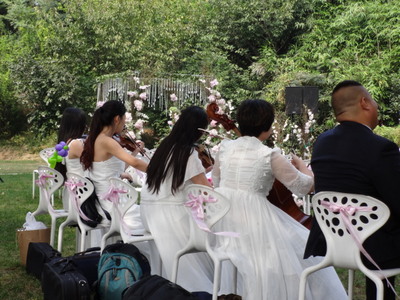
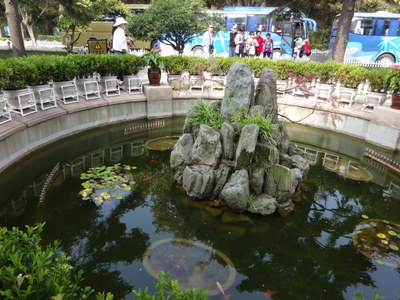 We think this string quartet (wrestling valiantly with Bach) were associated with the Wedding of the Large Crustaceans.
We think this string quartet (wrestling valiantly with Bach) were associated with the Wedding of the Large Crustaceans.
The fountain shown at the right was right in front of the house. In the background, you can see a couple of the many, many tour buses that started pulling up shortly after we arrived ourselves. They were all filled with Chinese tourists, for whom the house (in its "guest house" role) is apparently quite a draw. We really came to appreciate the system, which we'd seen a few times in France, where each tourist in a group is equipped with a receiver and earbuds, and the guide talks softly into a little transmitter. It enables several different tours, ouit of synch and sometimes even in different languages, to go on simultaneously, without the guides' having to shout or compete with each other.
Around the fountain, as I was taking my own photos, I encountered a new phenomenon for the first time—selfie wands. That's what I call them, anyway. They're telescoping metal rods about a foot long but extensible to maybe three or four feet, with a cradle on the end that holds a cell phone and is equipped with a little dingus that engages the shutter. At the other end is a trigger for activating the little dingus. They're designed for taking selfies from distances greater than arm's length! Quite a number of the tourists had them (not all were alike; there must be several brands) and were busily taking photos of themselves singly and in groups with picturesque or historical stuff in the background!
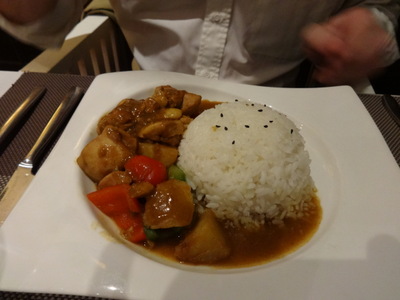
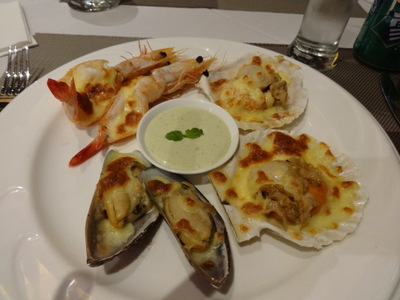 At lunch time, we repaired to the "Rats Kellar Western Restaurant" in the basement of the residence, where David had "chicken curry" and I had "seafood grilled with cheese." I was curious to learn whether this curry would be Indian style, Chinese style, or German style. It turned out to be a decidedly German curry—chicken chunks, potatoes, and carrots in a tasty but very mild brown sauce, served with rice.
At lunch time, we repaired to the "Rats Kellar Western Restaurant" in the basement of the residence, where David had "chicken curry" and I had "seafood grilled with cheese." I was curious to learn whether this curry would be Indian style, Chinese style, or German style. It turned out to be a decidedly German curry—chicken chunks, potatoes, and carrots in a tasty but very mild brown sauce, served with rice.
My seafood consisted of two large mussels on the half shell; two large prawns in the shell, split lengthwise and butterflied; and two scallops on the half shell, all sprinkled with very mild Swiss cheese and run under the broiler. In the center of the plate was something described as "mayonnaise" but tinted green with herbs of some sort. (It was garnished with a mint sprig but didn't taste of mint.) The scallops were entire—including not just muscle and roe but mantle and viscera as well—my first chance to try them that way. The mantle, though thin, lacy, and crisp, was surprisingly tough and chewy, but the whole thing was quite agreeable.
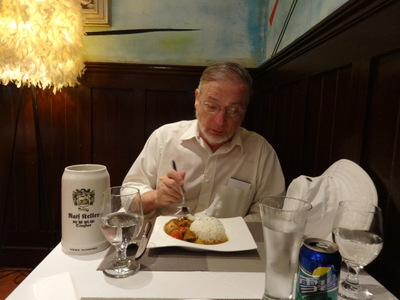
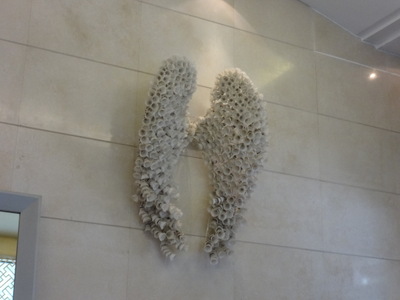 David ordered a beer and got a full liter in a tall stoneware mug (which you can see here at his elbow)! I couldn't see a water cooler, so I ordered a can of Sprite.
David ordered a beer and got a full liter in a tall stoneware mug (which you can see here at his elbow)! I couldn't see a water cooler, so I ordered a can of Sprite.
When the time came to head back to our hotel, we addressed ourselves to the desk of "The Castle," which shares the grounds of the governor's residence. It occupies several buildings (the red, green, and black castles), and except for those words, all its signage is, of course, in Chinese, so for most of our time in the area, we were baffled as to what it actually was. Fortunately, I finally encountered a small sign directing people toward it that said "The Castle boutique hotel."
As usual, once you can find a hotel reception desk, a taxi is no problem. They called us one, we showed the driver our "please take me to" note for our hotel, and off we went. While we waited for the taxi though, I got this shot of a large pair of wings mounted on the wall above the reception desk and made entirely of real, cork-and-feather badminton shuttlecocks.
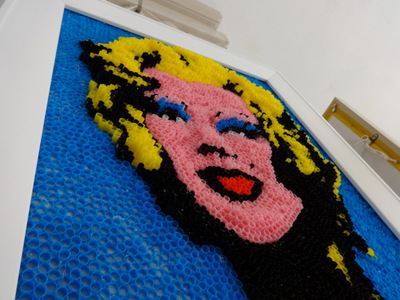
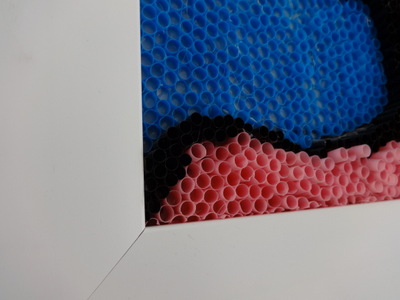 After resting our feet for a while, we walked back up to the Huang Hai Hotel for the conference's late-afternoon registration and opening reception. For the occasion, several of the LCD signs in the hotel's lobby were actually displaying some English, directing us to the registration desks and conference center. The organizers had mustered quite a respectable number of student volunteers who spoke reasonable English—the official language of the meeting was English, as is the case for almost all international meetings these days, so all the participants expected to be able to transact their business in English.
After resting our feet for a while, we walked back up to the Huang Hai Hotel for the conference's late-afternoon registration and opening reception. For the occasion, several of the LCD signs in the hotel's lobby were actually displaying some English, directing us to the registration desks and conference center. The organizers had mustered quite a respectable number of student volunteers who spoke reasonable English—the official language of the meeting was English, as is the case for almost all international meetings these days, so all the participants expected to be able to transact their business in English.
In the passageway between the registration desks and the conference center was a display of art, including this portrait of Marilyn Monroe made of cross sections of plastic soda straws. It's difficult to see from the photo, but it's actually in relief—the background blue is made of thin rings, but her chin and cheekbones are composed of longer sections, which stick out farther from the background. The effect may be a little easier to see in the right-hand close-up of MM's right shoulder.
At the right is a view of the main hall. For this occasion, it was thrown open, but for many of the sessions, it was divided into a fairly large room (with the screen you can see here) and a smaller one across the back in which the chairs were turned 90 degrees to face a screen at right angles to the big one. Two other slightly smaller rooms were also used, so four sessions could go on simultaneously.
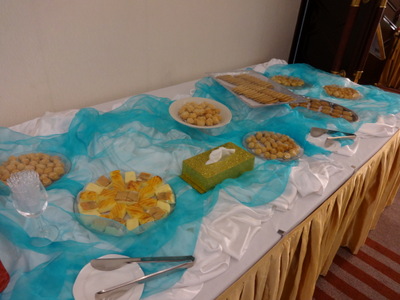
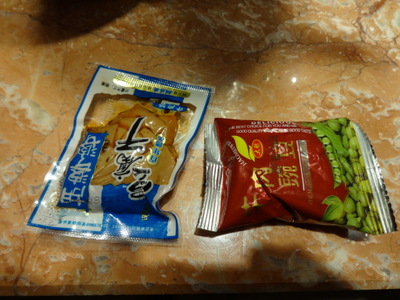 Food for the reception consisted of this assortment of cookies and little square pastries (excellent almond and sesame cookies) and a table covered with large bowls of gaudily packaged Asian snack foods.
Food for the reception consisted of this assortment of cookies and little square pastries (excellent almond and sesame cookies) and a table covered with large bowls of gaudily packaged Asian snack foods.
Note, on the cookie table, the box of Kleenex provided to serve as napkins.
From the snack foods, I selected two to try later. The one on the right is a packet of little roasted, salted green peas. Good, but not as good as the Japanese ones coated with wasabi. The packet on the right turned out to contain little flat squares of something beige with bits of red hot red chiles embedded in them, packed in oil. I think it was tofu, or maybe wheat gluten, quite firm and chewy. It managed to be both mildly spicy and completely bland, and I didn't bother to finish it.
For dinner, we decided to try our hotel's Japanese restaurant, where we figured ordering would be easier. Wrong. First, you have to find the place. Fortunately we happened to find, while exploring our hotel's convention center on evening after dinner, an elevator far down a hallway from the lobby with a plaque next to it that said, "Japanese restaurant, 2F." Sure enough, that elevator opened, on the second floor, directly into the restaurant's lobby. The staff there spoke just about no English. We were shown to a private tatami room, one of those dining rooms with a very low table, at which you sit cross-legged on the floor. Fortunately, this one had a well underneath so that westerners could sit "normally" at it. I don't know whether they were all like that or they just have a few for foreigners. The waitress took off her clogs at the door before ushering us in, so we took our shoes off, too, although we were unable to ask whether we were supposed to. She seemed a little surprised.
We were presented with a photo-album menu, the doors were closed, and we were left to it. David wasn't very hungry, so we decided just to have some sushi. We flipped through all the noodle dishes, hot pots, tempura assortments, etc., to the sushi section, which was at the end, and, when the waitress returned, set about pointing to the ones we wanted and holding up fingers to indicate how many. Unfortunately, "two" could mean either "two pieces per order" or "two orders," so we weren't sure just what we'd get. When we had finished, after many attempts at communication, which neither she nor we understood, the waitress seemed distressed. She flipped back through the menu and pointed inquiringly to other dishes. When we refused them, she went away and came back with a cell phone, whose screen said "We are buffet, you take only small bit." We took that to mean only that we were ordering an abnormally small amount of food for a a meal and not taking advantage of the variety on the menu—we saw no evidence of an actual buffet anywhere. Fortunately, "okay" is internationally understood, so we finally convinced her we had ordered all we wanted.
We did, in fact, get what we'd ordered but in seemingly random quantities. That was fine with me, because I was hungrier than David and happily polished off the extras. The food arrived in shifts, and a short while after the last of it was, the waitress returned with a cell phone whose screen said, "Our food on the whole?"
Baffled, we made signs of incomprehension. Were they asking for an evaluation of the food? Eventually she went away, and a while later, a different young woman came to the door (dressed more for the kitchen than for the dining room) and asked "Is that all?" Assured that it was, she went away, and nobody ever came back.
Eventually, we ventured out of our room, put our shoes back on, and walked back down the hallway to the reception desk, where they seemed to be expecting us and had our check ready. We could faintly hear other diners somewhere in the distance but never saw another customer. An odd experience altogether. I didn't take photos, but the sushi looked just like sushi.
The hotel also claimed to have a "Hong Kong restaurant," but we never found it. The hotel's floor plan showed it in a location that was actually occupied by a series of rooms, each with a name over the door, like a conference room, opening off the major hallway leading to the conference center. When we followed the signs to a "Hong Kong restaurant" in the Huang Hai, we at least found a reception desk (bare, empty, and deserted) with the name "Hong Kong restaurant" on the wall over it, but again, the only thing behind it was a hallway with named rooms opening off it. Only when we happened to walk by one of the the "conference rooms" in our hotel when the door was ajar and saw people eating in side did we deduce that a Hong Kong restaurant must consist of a series of private dining rooms served, presumably, through doors in the back walls. To go there, you must have to make a reservation at the hotel's reception desk, then be conducted to your private room. Anybody encountered this kind of thing before?
Later that night, I got a call from the reception desk, asking me to come downstairs to pay the room deposit again. I showed them the receipt that David had gotten when he paid it the night we arrived, but it turns out that was only for one room. Fortunately, they seemed to have solved the problem with reading the credit card, as I was able to pay the second deposit without difficulty.
previous entry
List of Entries
next entry

 The house was, of course, quite Germanic but seemed substantial and comfortable. We got an English-language audioguide (called a "voice guide" here; I had to use pantomime to ask for it, as the word "audioguide" was unknown) for 20 yuan each, plus a 200 yuan deposit.
The house was, of course, quite Germanic but seemed substantial and comfortable. We got an English-language audioguide (called a "voice guide" here; I had to use pantomime to ask for it, as the word "audioguide" was unknown) for 20 yuan each, plus a 200 yuan deposit. 
 After the building finally reverted to China, its name was changed to "The Guest House," and it hosted official visitors to the city. Mao stayed there many times as did every other Chinese leader famous enough for me to have heard of. It became a museum in the sixties. The audioguide explained that the wood used in the construction was specially treated for durability, so the parquet floors and other woodwork are still uncracked and in perfect shape. Much of the furniture is old-fashioned heavy German construction, beautifully designed. The art nouveau decoration was mentioned frequently but showed up mainly as trim rather than major elements. David especially liked the ceilings. The chandeliers, on the other hand, were uniformly pretty ugly; maybe they were nicer when still copper colored rather than their present black.
After the building finally reverted to China, its name was changed to "The Guest House," and it hosted official visitors to the city. Mao stayed there many times as did every other Chinese leader famous enough for me to have heard of. It became a museum in the sixties. The audioguide explained that the wood used in the construction was specially treated for durability, so the parquet floors and other woodwork are still uncracked and in perfect shape. Much of the furniture is old-fashioned heavy German construction, beautifully designed. The art nouveau decoration was mentioned frequently but showed up mainly as trim rather than major elements. David especially liked the ceilings. The chandeliers, on the other hand, were uniformly pretty ugly; maybe they were nicer when still copper colored rather than their present black.
 Outside on the grounds, no fewer than four different weddings were in preparation, one of which seemed to be bilingual. From the snapshots posted at the welcome table, we gathered that both partners were of Asian descent but that at least one of them was from an English-speaking country and had invited friends and family from there. The few non-Asian faces we saw hanging around there were among the extremely few we saw in China, apart from participants in the Biodiversity Conference.
Outside on the grounds, no fewer than four different weddings were in preparation, one of which seemed to be bilingual. From the snapshots posted at the welcome table, we gathered that both partners were of Asian descent but that at least one of them was from an English-speaking country and had invited friends and family from there. The few non-Asian faces we saw hanging around there were among the extremely few we saw in China, apart from participants in the Biodiversity Conference.
 We think this string quartet (wrestling valiantly with Bach) were associated with the Wedding of the Large Crustaceans.
We think this string quartet (wrestling valiantly with Bach) were associated with the Wedding of the Large Crustaceans. 
 At lunch time, we repaired to the "Rats Kellar Western Restaurant" in the basement of the residence, where David had "chicken curry" and I had "seafood grilled with cheese." I was curious to learn whether this curry would be Indian style, Chinese style, or German style. It turned out to be a decidedly German curry—chicken chunks, potatoes, and carrots in a tasty but very mild brown sauce, served with rice.
At lunch time, we repaired to the "Rats Kellar Western Restaurant" in the basement of the residence, where David had "chicken curry" and I had "seafood grilled with cheese." I was curious to learn whether this curry would be Indian style, Chinese style, or German style. It turned out to be a decidedly German curry—chicken chunks, potatoes, and carrots in a tasty but very mild brown sauce, served with rice.
 David ordered a beer and got a full liter in a tall stoneware mug (which you can see here at his elbow)! I couldn't see a water cooler, so I ordered a can of Sprite.
David ordered a beer and got a full liter in a tall stoneware mug (which you can see here at his elbow)! I couldn't see a water cooler, so I ordered a can of Sprite.

 After resting our feet for a while, we walked back up to the Huang Hai Hotel for the conference's late-afternoon registration and opening reception. For the occasion, several of the LCD signs in the hotel's lobby were actually displaying some English, directing us to the registration desks and conference center. The organizers had mustered quite a respectable number of student volunteers who spoke reasonable English—the official language of the meeting was English, as is the case for almost all international meetings these days, so all the participants expected to be able to transact their business in English.
After resting our feet for a while, we walked back up to the Huang Hai Hotel for the conference's late-afternoon registration and opening reception. For the occasion, several of the LCD signs in the hotel's lobby were actually displaying some English, directing us to the registration desks and conference center. The organizers had mustered quite a respectable number of student volunteers who spoke reasonable English—the official language of the meeting was English, as is the case for almost all international meetings these days, so all the participants expected to be able to transact their business in English.
 Food for the reception consisted of this assortment of cookies and little square pastries (excellent almond and sesame cookies) and a table covered with large bowls of gaudily packaged Asian snack foods.
Food for the reception consisted of this assortment of cookies and little square pastries (excellent almond and sesame cookies) and a table covered with large bowls of gaudily packaged Asian snack foods.